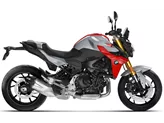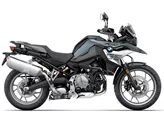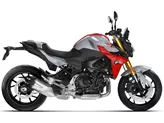BMW F 800 R 2017 vs. Honda CB650F 2017

BMW F 800 R 2017

Honda CB650F 2017
Overview - BMW F 800 R 2017 vs Honda CB650F 2017
The BMW F 800 R 2017 and the Honda CB650F 2017 are both naked bikes that offer a thrilling riding experience. However, there are several differences between the two models that make them unique.
Starting with the engine and drive train, both bikes have inline engines with fuel injection systems. The BMW F 800 R has a 2-cylinder engine with 90 HP of power and 86 Nm of torque, while the Honda CB650F has a 4-cylinder engine with 91 HP of power and 63 Nm of torque. The BMW F 800 R has a slightly higher power output and torque, which may result in better acceleration and top speed.
In terms of cooling, both bikes use liquid cooling systems to maintain optimal engine temperature. This ensures that the engines perform efficiently and prevents overheating during long rides.
Moving on to the suspension, the BMW F 800 R is equipped with an upside-down telescopic fork at the front and a swing arm at the rear. This setup provides excellent stability and control, especially during cornering. On the other hand, the Honda CB650F has a telescopic fork at the front and a swing arm at the rear. While it may not have the upside-down fork like the BMW, it still offers a comfortable and responsive ride.

BMW F 800 R 2017
When it comes to the chassis, the BMW F 800 R has an aluminum frame, which is known for its lightweight and sturdy construction. This contributes to the bike's low weight of 202 kg, making it easier to handle and maneuver. In contrast, the Honda CB650F has a steel frame, which may add a bit more weight to the bike, but also provides durability and stability.
In terms of braking, both bikes feature double disk brakes at the front. However, the BMW F 800 R has four pistons in its front brake system, while the Honda CB650F has double pistons. The BMW's radial brake technology also enhances its braking performance, providing strong and precise stopping power.
In terms of advanced rider assistance systems, the BMW F 800 R offers electronically adjustable suspension, which allows riders to customize their suspension settings according to their preferences and road conditions. On the other hand, the Honda CB650F comes with ABS (Anti-lock Braking System), which prevents the wheels from locking up during sudden braking, ensuring stability and control.

Honda CB650F 2017
When it comes to dimensions and weights, both bikes have the same front and rear tire widths and diameters. However, the BMW F 800 R has a slightly longer wheelbase of 1520 mm, compared to the Honda CB650F's 1450 mm. This may result in better stability and handling for the BMW. The seat height of the BMW F 800 R can be adjusted between 790 mm and 820 mm, while the Honda CB650F has a fixed seat height of 810 mm. The BMW F 800 R has a fuel tank capacity of 15 liters, while the Honda CB650F has a larger capacity of 17.3 liters, allowing for longer rides without refueling.
In terms of strengths, the BMW F 800 R has strong brakes, upgraded equipment, low weight, accessible geometry, and a characteristic sound. On the other hand, the Honda CB650F has sufficient torque even at low revs, a sporty chassis, LED lighting technology, and a grown-up look.
However, the BMW F 800 R has a somewhat pragmatic design, and some riders may find that it lacks a bit of excitement. On the other hand, the display of the Honda CB650F may be difficult to read in certain lighting conditions.
In conclusion, both the BMW F 800 R 2017 and the Honda CB650F 2017 are excellent naked bikes that offer a thrilling riding experience. The BMW F 800 R has a slightly more powerful engine and adjustable suspension, while the Honda CB650F has a sportier chassis and LED lighting technology. Ultimately, the choice between the two models will depend on the rider's preferences and priorities.
Technical Specifications BMW F 800 R 2017 compared to Honda CB650F 2017
Pros and Cons in comparison
Pros and Cons in comparison
BMW F 800 R 2017

With a EURO4 engine, new riding modes, new instruments and new colours, the F 800 R starts the new season. It is recognisable at first glance only by the end cap on the stately stainless steel exhaust. It is one of those full-grown motorbikes that, despite its considerable sporting potential, was designed for the widest possible user group. Therefore, it is absolutely beginner-friendly (throttled), but can also inspire an experienced audience. Its character remains somewhat pragmatic, but the unmistakable, hollow sound of the inline two compensates for this.
Honda CB650F 2017

In its latest stage of development, the 2017 Honda CB 650 F is exactly the four-cylinder naked bike we wanted from Honda. Crisp engine tuning and a shorter gear ratio ensure a quick sprint to 100 km/h, including a screaming four-cylinder sound. The chassis tuning is also very sporty, which makes you feel comfortable on the Honda right away. With LED lighting technology, Honda proves that the CB 650 F is in step with the times, only the display deserves a makeover.
Price Comparison Avarage Market Price BMW F 800 R vs Honda CB650F
There are a few key differences between a BMW F 800 R 2017 and a Honda CB650F 2017. There are the same number of bikes of both models available on the 1000PS.de marketplace, specifically 16. It takes less time to sell a Honda CB650F with 72 days compared to 105 days for the BMW F 800 R. Since model year 2009 1000PS.de editors have written 20 reviews for the BMW F 800 R and 14 reviews for the Honda CB650F since model year 2014. The first review for the BMW F 800 R was published on 10/10/2008 and now has more than 8,900 views. This compares to more than 14,100 views for the first review on Honda CB650F published on 04/11/2013.






















